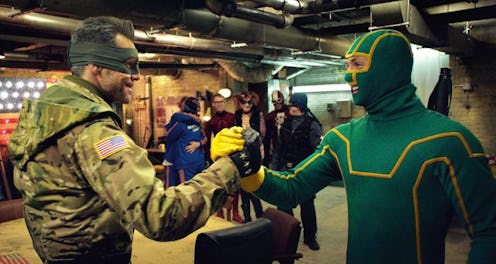Entertainment
One Year After 'Aurora,' Movies Are Still Violent

On Friday at Comic-Con, a new extended trailer for the upcoming sequel Kick-Ass 2 was released. At four-and-a-half minutes, it's full of shooting, slashing, stabbing, and spewing of blood, not to mention some extremely foul language, all set to a pretty hip soundtrack. Overall, it's a fun trailer, but darkened by the fact that last month, Kick-Ass 2 star Jim Carrey, who plays Colonel Stars and Stripes, spoke out on Twitter to distance himself from the project. "I did Kickass a month b4 Sandy Hook and now in all good conscience I cannot support that level of violence," he said.
This week also marked the one year anniversary of the horrific massacre in Aurora, Colo., which happened during a screening of The Dark Knight Rises. Post-Aurora, a difficult conversation was forced to be had in Hollywood — what role does the media play in affecting real-life violence? However, this subject is certainly a tale as old as time — just think back to, most notoriously, Charles Manson and his "Family" deriving their Helter Skelter prophecies from The Beatles. So in the year since the Aurora shootings, has violence in the media changed?
Apparently, not much. Though last summer, Harvey Weinstein called for a summit of directors to reevaluate their influence by using violence in their movies, the summit never materialized. Instead, this year has seen the success of strongly violent films like Iron Man 3, Man of Steel, and Fast & Furious 6. As Janice Min of The Hollywood Reporter said "The issue makes a lot of people uncomfortable in Hollywood — they don't really want to deal with it."
Unfortunately, it seems the public still has a demand for on-screen violence, which will only further the delay of a conversation to change the nature of violence in the media. Though there have been no solid studies that show a link between media violence and actual violent crimes, Hollywood can't forever deny their power over the cultural attitudes and appetite for violent images.